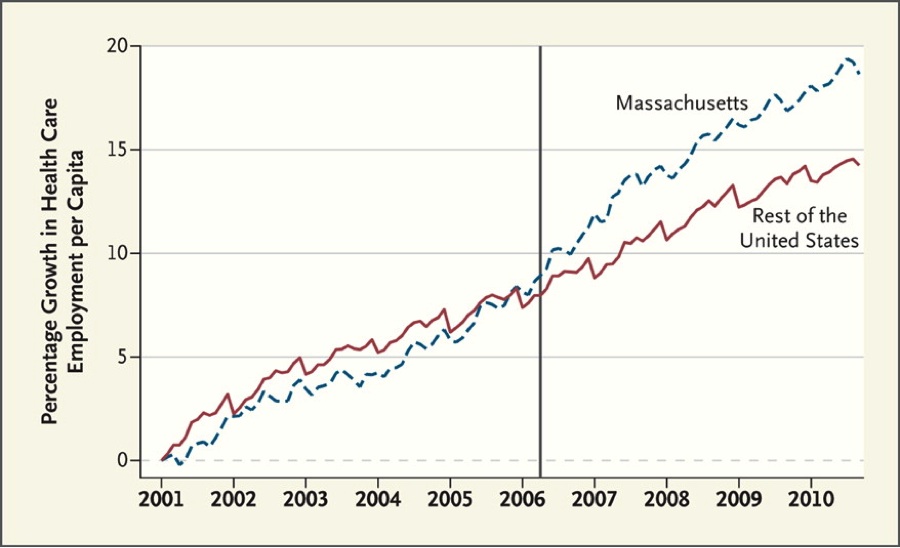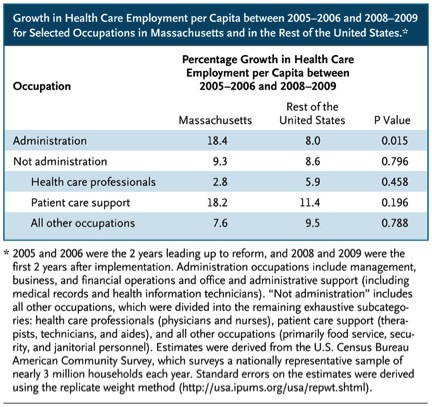RomneyCare and Jobs
Stanley Feld M.D.,FACP,MACE
Everyone except Mitt Romney agrees RomneyCare was used as a model for President Obama’s healthcare reform act. Mitt Romney insists that on the first day of his Presidency he will repeal Obamacare. He contends that healthcare reform should be a state problem. Each state should choose what is right for itself.
RomneyCare was enacted in 2006. It was implemented it in 2007. It offered insurance subsidies for low-income individuals, expanded Medicaid coverage and created an individual mandate to obtain insurance. Pay-or-play requirements for employers were imposed on employers. It created a state insurance exchange through which many of the newly insured Massachusetts residents obtained coverage.
It sounds like Obamacare.
In Massachusetts 98% of its citizens have healthcare insurance coverage. Massachusetts has also experienced a large increase in health insurance premiums. The healthcare insurance costs have nearly doubled in Massachusetts. There is increasing political pressure and public opinion opposing the increasing budget deficit resulting from RomneyCare.
President Obama has bailed out Massachusetts twice to the tune of 8 billion dollars.
The study looked at job growth in the healthcare sector in Massachusetts since the implementation of RomneyCare.
My impression in 2007 was that Massachusetts would experience an increase in healthcare costs, an increase in budget deficits and a decrease in availability of medical care.
I also knew there would be an increase in administrative costs and administrative jobs. Anytime a new bureaucracy is begun there is an increase in hiring bureaucrats. Many times bureaucrats’ income is higher than physician’s income.
The study showed there was an increase in job growth in the healthcare sector. The increase in hiring was 5.5% greater than job growth in the rest of the United States’ healthcare sector.
“Had health care employment in Massachusetts grown at the same rate as in the rest of the country, approximately 18,000 fewer people would have been employed in health care by 2010.”
From 2005–2006 to 2008–2009, employment per capita in administrative occupations grew by 18.4% in Massachusetts, as compared with 8.0% in the rest of the country (P=0.015).
This data clearly confirms my bias. The data shows a pattern that should be obvious to all.
Unfortunately, none of the differences in percentage in each category are statistically significant. In order for a comparison to be statistically significant the p value must be less than .05. A p value of 0.015 is greater than .05. It is not statistically significant.
Two weeks ago I had an email exchange with a reader about the importance of accurate data. Data is scientific and complicated. It increases the complexity of the healthcare system.
The reader wrote,
“With the advent of HIT products such as EHR’s, registries and “smart” hardware, it is now much easier to access data that can be used to drive improved outcomes. Most EHR’s can provide population level data that can be used to view the level of care presently rendered and to track changes in outcomes as new processes and hardware are adopted.
It will be necessary in the near future for providers to develop their skills in using data to modify processes at their site so that the patient outcomes are significantly better. New payment models based upon quality of care will require this. Successful employment of these techniques will be rewarding for all involved—patients, providers and payers.
Have a great weekend.”
I replied,
“If data is not accurate and the results are not statistically significant, the conclusions, decisions and policy on the basis of the data are not going to be good.
I have seen business data and healthcare policy data that has been poor, inaccurate and not statistically significant pose as accurate scientific data. This data has led to faulty business and health care policy decisions. “
Physicians have been paranoid about the collection of data evaluating their performance. Both valid and invalid data have been used to penalize them. Data collections should be used as a learning experience not as a punitive weapon to reduce reimbursement.”
Toyota has done it in its factory auto production. My reader continues
“This approach to providing quality in services and products has been used for many years outside of healthcare. Toyota developed a unique approach based principally on plan-do-check-act (PDCA) and teamwork that resulted in a superior product that enabled them to be the standard of quality in production for many years.”
It is time the physicians adopt this model. Unfortunately it will not happen until the competing learning systems (experiential, [physicians learning] and complicated [data collection]) are managed effectively and stakeholders’ incentives are aligned.
It is time the healthcare system started to use accurate data. Accurate data can extend the legacy experience of physicians. Only then will the healthcare system start aligning incentives.
Some healthcare providers are starting to adopt data driven models such as PDCA. I believe adoption can only be driven by trust among stakeholders. Patients are first and they must assume responsibility to drive the system.
The only way they will do that is if they have a financial incentive to drive the system.
I will try to describe a framework necessary for consumers of healthcare to drive the healthcare system. Successful employment of these techniques will be rewarding for all involved—patients, providers and payers.
The opinions expressed in the blog “Repairing The Healthcare System” are, mine and mine alone.


Michelle • October 19, 2011
If people really want quality insurance, it is available and affordable. They just need to make it a priority in their budget and call health insurance reps to find them the best deals that fit them.
Darwin • November 9, 2011
I don’t understand why you say 0.015 > 0.05. It is not.